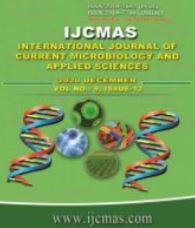


 National Academy of Agricultural Sciences (NAAS)
National Academy of Agricultural Sciences (NAAS)

|
PRINT ISSN : 2319-7692
Online ISSN : 2319-7706 Issues : 12 per year Publisher : Excellent Publishers Email : editorijcmas@gmail.com / submit@ijcmas.com Editor-in-chief: Dr.M.Prakash Index Copernicus ICV 2018: 95.39 NAAS RATING 2020: 5.38 |
It is review highlighting the speed breeding future prospects Speed breeding is revolutionary tool of breeding technology by reducing crop generation time. It’s a concept of extending the duration of plants daily exposure to light combined with early seed harvest to quickly from seed to seed by reducing the times of generation for some long day and day neutral crops. Basically, this experimental research was conducted in three methods they are Speed breeding I - Controlled-environment chamber speed breeding. Speed breeding II - Glasshouse speed breeding conditions Speed breeding III - Homemade growth room design for low cost speed breeding. Developed by teams at the John Innes Centre, University of Queensland and University of Sydney. Dr Lee Hickey from the University of Queensland and Speed breeding concept was inspired by NASA’s efforts to grow food on space stations which allows faster selection and population development. It was first described and implemented for wheat and peanut (Arachis hypogaea). Variations of this approach have been demonstrated to be an efficient system for rapid screening of wheat germplasm for adult plant resistance to various diseases and also for pyramiding multiple disease resistance in barley. This approach has also been adapted for high density plant production systems for SSD programs and also be created some of these artificial stimulating conditions used in this speed breeding technique the breeding technique uses modified temperature conditions and replacing the traditional artificial light like sodium vapour lamps or halogen lamps by LEDS light emitting diodes as a supplementary light source for extending photo periodism is used and to speed up the crossing and inbreeding of varieties speed breeding protocols designed different for different species altering the light treatments and modifying temperatures need to be optimized subsequently .the optimal conditions to be followed in speed breeding in light spectrum that used PAR region of (400-700 nm) with mainstream focus on the blue red or far red regions of the spectra. A light/dark period was chosen over a continuous photoperiod to support functional expression of circadian clock genes. Specific photoperiod length of 22-h with 2-h of darkness is recommended to improve the plant health (for other species like wheat, barley, oat 18 h photo period is enough). Optimum temperature regime should be applied its aids in stress recovery. In most of the conditions at UQ, a 12-h 22 °C/17 °C temperature cycling regime with 2 h of darkness occurring within 12 h of 17 °C has proven successful. Humidity, but a reasonable range of 60–70% is ideal. For crops that are more adapted to drier conditions, a lower humidity level may be advisable. A evaluation of speed breeding approaches was compared in two specific conditions of light like 22-h & temperature 17 degree in glass house with some genotypes of wheat, barley, oat, Brachypodium distachyon (purple false brome)as a correspondence with other crops grown in glass house the crops which undergone the speed breeding with specific conditions has grown with other half time from other crops grown in normal glass house conditions. This plays pivotal role in plant breeding technology by meeting the needs of ever-growing population the speed breeding had some disadvantages over dwarf plants. The continuous exposure of light may deplete the trait of dwarfness in plants this should be the concerning trait of improvement for some major crops like one of them is rice (Oryza sativa).
 |
 |
 |
 |
 |